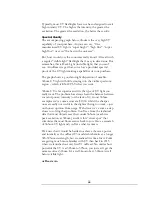
5
to be conservative and so you may even achieve up to 700 to
1000. These are known as “charge cycles” where one-cycle is
equivalent to fully charging the cell and then fully discharging
the cell. To further optimize the full working life of the 18650
cell it is better practice to charge the cell when it is about 80%
depleted rather than fully depleted, although full depletion
with a “protected” cell is however still acceptable.
For those of you who just might have geek-ish inclinations,
the supplied cells are not “true” or pure ICR types (i.e.
lithium-cobalt), since they also have good amounts of Nickel
and Manganese (similar to INR and IMR) in them, more so
than the older or more prevalent lithium-cobalt type (ICR).
You really have made a wise choice. The Li-ion cell is often
hailed as the “cell of the future” due to its relatively high
voltage and its ability to sustain discharge at relatively high
voltage levels. So any flashlight using a Li-ion cell is a good
indication that there’s serious power on tap. But, the number
one advantage is that being rechargeable they’ll save you a
large cost outlay on non-rechargeable cells, bringing down the
total-cost-of-ownership of a flashlight to very low levels.
Especially when you consider they’ll last for years to come,
after which you simply buy a new set to start the lifetime-cycle
again.
How to charge
Note that there are two accessories including for use when
charging: (1) A USB-C cable, and, (2) A USB mains power
adapter (optional to use).
Using the USB-C cable supplied connect one end to the on-
board charge port just under the LED head, and connect the
other USB end to a power source. Then PRESS THE
FLASHLIGHT on/off BUTTON TO THE ON
POSITION. Charging will begin and completes when the
charge light indicator changes color. For fastest charging
(optional) use the supplied mains adapter and connect the
adapter to a mains supply power socket.
USB-C
The charge cable is a USB-C type. This is the next generation
progression from micro-USB. Micro-USB is used by many
older design flashlights. The distinct advantage of USB-C over
micro-USB is much faster charging time. You’ll notice this is






































